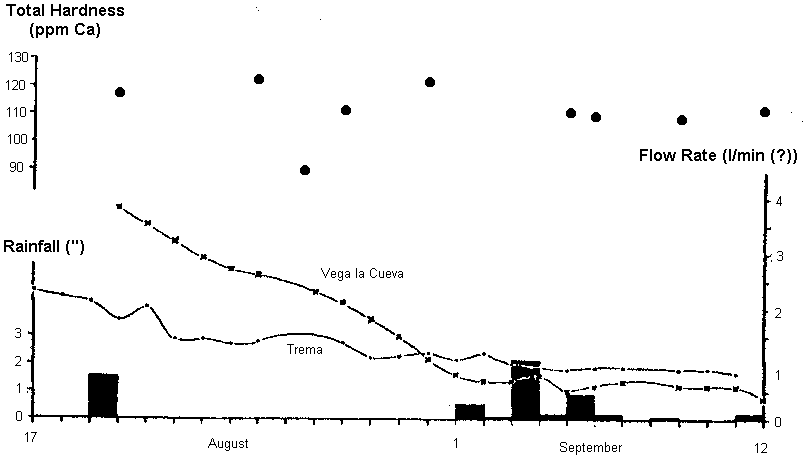
OUCC Proceedings 9 (1979)Hydrological Notes |
OUCC Proceedings 9 Index |
by Martin Laverty
Little attention has been paid to the hydrology of this area since the 1961 Oxford Expedition monitored flow at two springs, and the hardness at one, over a 4 week period. They also proved two hydrological connections by dye tracing. Their results are reproduced here on the area sketch map for ease of comparison and completeness. During the 1979 expedition, and attempt to trace the water from Cueva del Frieru to the sump in Cueva del Viento and/or to the resurgence of the Rio Redemuna was attempted but not completed, due to lack of time and people to collect the detectors. A number of water samples were, however, analysed for Ca and Mg hardness, using standard EDTA titration method with plastic burette, beakers etc. A number of conductivity ratings were also taken, and the response of the cave streams to rainfall noted.
Titration results:
| Location | Date (1979) |
Hardness in ppm CaCO3 |
Comments | |
Ca |
Ca+Mg |
|||
| C. del Osu, main stream | 13/7 | 94 | 96 | Moderate flow |
| 17/7 | 94 | 96 | Much lower flow | |
| C. del Viento entrance spring | 23/7 | 92 | 95 | |
| 2/7 | 88 | 98 | 2 days after hail | |
| C. del Viento sump | 2/7 | 80 | 82 | 2 days after hail |
| El Hoyo la Madre entrance pool | 26/7 | 92 | 96 | |
| Fuente Ercina (water supply) | 27/7 | 98 | 100 | |
| Lago Ercina | 27/7 | 64 | 66 | |
| Seepage on path to Osu | 13/7 | 118 | 122 | |
| Fuente at Ario | 31/7 | 98 | 108 | |
| Trema Spring | 1961, /8+ /9 | 113 (mean) | Reported as ppm Ca (=282 ppm CaCO3) by mistake? | |
The nature of this area with predominantly bare limestone surfaces and very little allogenic drainage suggest that it should be a rather good place to study limestone solution in an environment almost unaffected by the organic matter or CO2 which is so important in soil covered areas, or by the mixing of authigenic and allogenic waters. The relative uniformity of the results is thus quite encouraging for a carefully arranged sampling programme to be organised in the future to identify the spatial and temporal influences and their effects in more detail.
It appears that water in the caves enters through the percolation system and becomes saturated at about 90ppm CaCO3 with low percentage of Mg in most cases. Higher solute levels could well reflect the influence of soil cover, in the examples above, or may be related to longer residence time in the aquifer. The water in Lago Ercina must gradually build up its hardness in the dry periods in between storms, when considerable contributions of very dilute rainwater enter it, sometimes even in the form of saturated overland flow.

Discharge results for the Trema and Vega la Cueva Springs, and eight
total hardness values for Trema,
recorded by the 1961 Oxford Expedition to Northern Spain (C.R.G. Pub. 14,
1965)
The Trema and Vega la Cueva springs obviously require checking to determine whether or not the 1961 results were reported in the wrong units (1ppm Ca = 2.5ppm CaCO3). If so, they correspond with the value for the very small seepage on the path to Osu. Otherwise, the situation is more complicated, perhaps in a similar way to that found by Tringham in the Teverga area to the west of Oviedo. There, Namurian limestone resurgences all had Ca values around 77ppm CaCO3, but a resurgence from a Devonian limestone yielded water with hardness of 180ppm.
Conductivity readings for the seepage springs feeding the Rio Resecu, Rio Redemuna, and the small stream rising outside the Cueva del Viento entrance tend to indicate that they show a variety of fairly high hardness waters. Single springs are sometimes fed by several sources with different hardness. Temperatures also vary from about 4°C or less, to 13°C. A large resurgence from a boulder choke in the Redemuna Valley has good prospects for a lengthy cave behind it, as judged from the low conductivity and low (6°C) temperature of its waters, mainly meltwater, perhaps.
The response time for flowing water in the cave streams or in drips was very fast. In both Osu and Xitu a sudden increase lagged about 2 hours behind surface storms. The flow also decreased quite quickly, indicating a vry well developed, rapid percolation system.
It is clear that flooding could be a significant hazard, even in caves which usually appear rather dry. Thus, Viento is usually described as a dry cave, but the entrance series clearly sumps, and the normally dry streamway in Osu can become quite sporting, and possibly impassable at the cascades. Xitu entrance series has also been seen to become very wet.
Reference:
| Tringham, M (1975) | Notes on karst water hydrology. Report of the 1976 Imperial College expedition to the Cantabrian Mountains, Teverga. 19-21 |